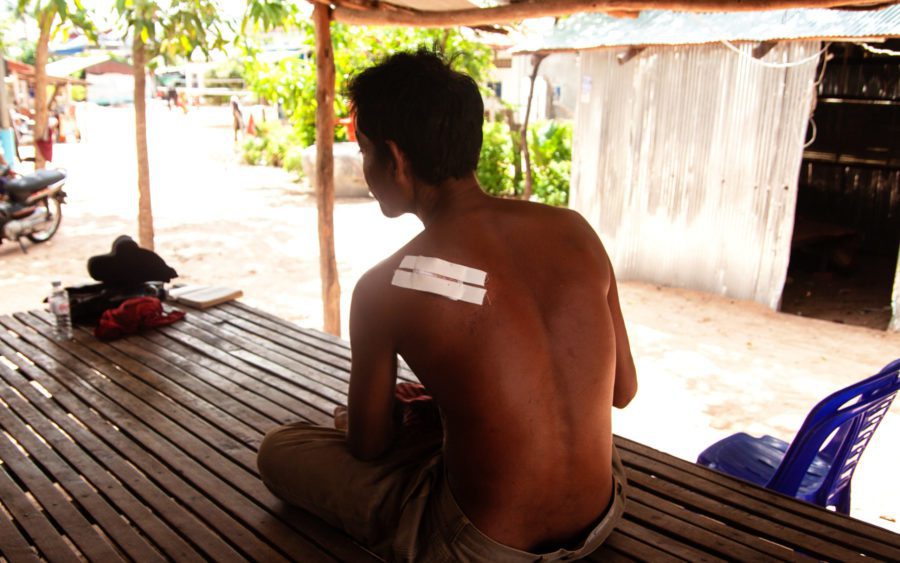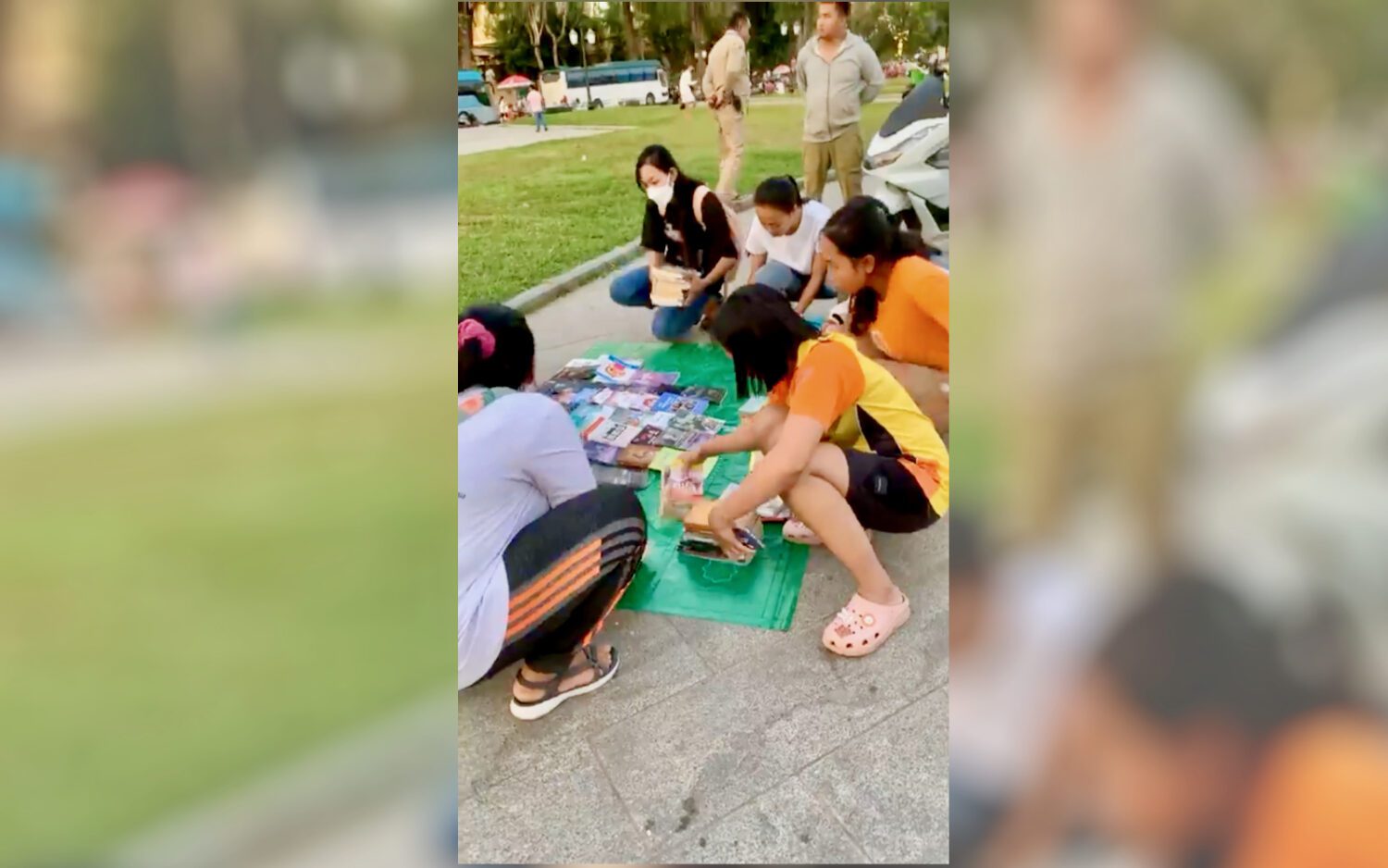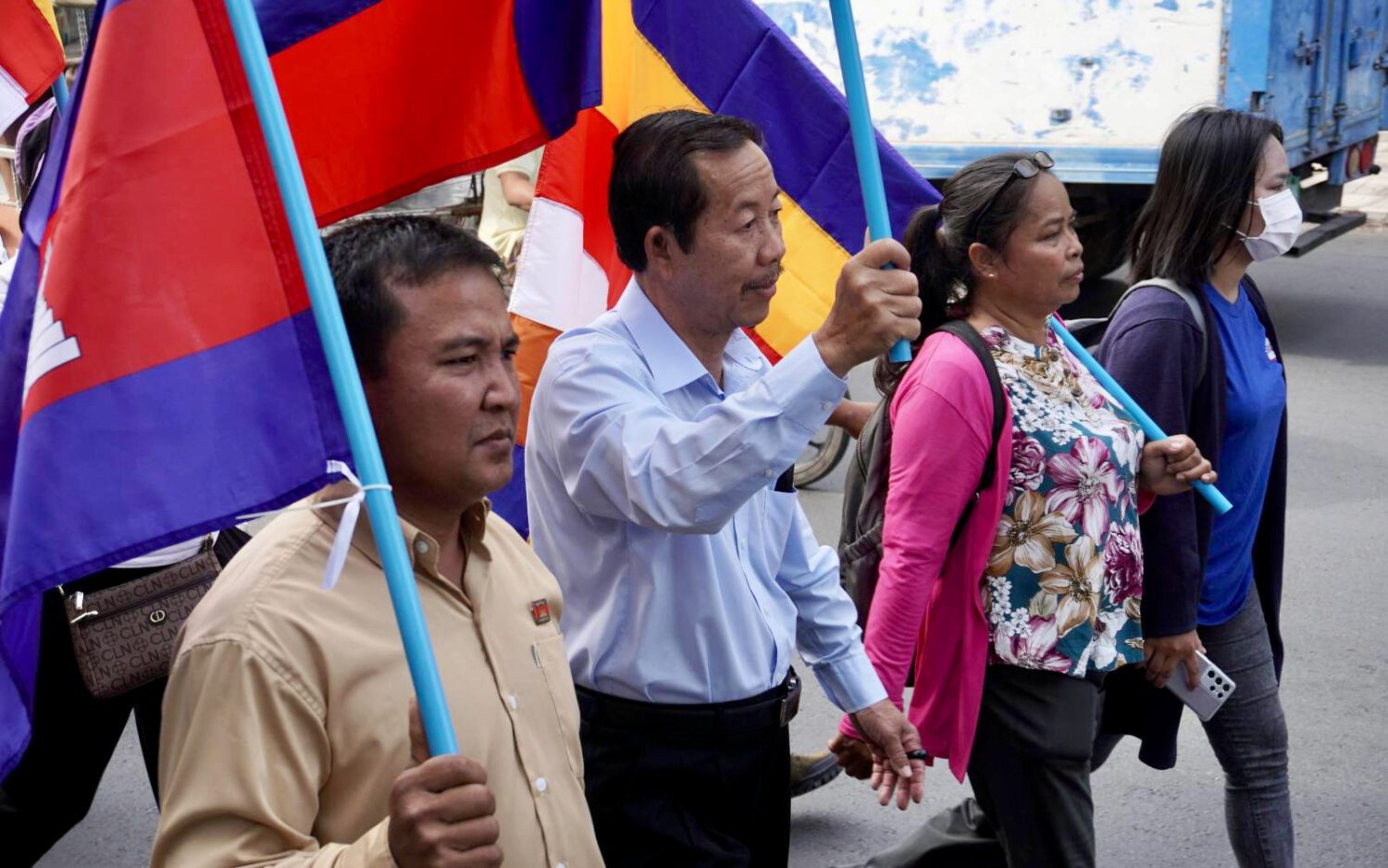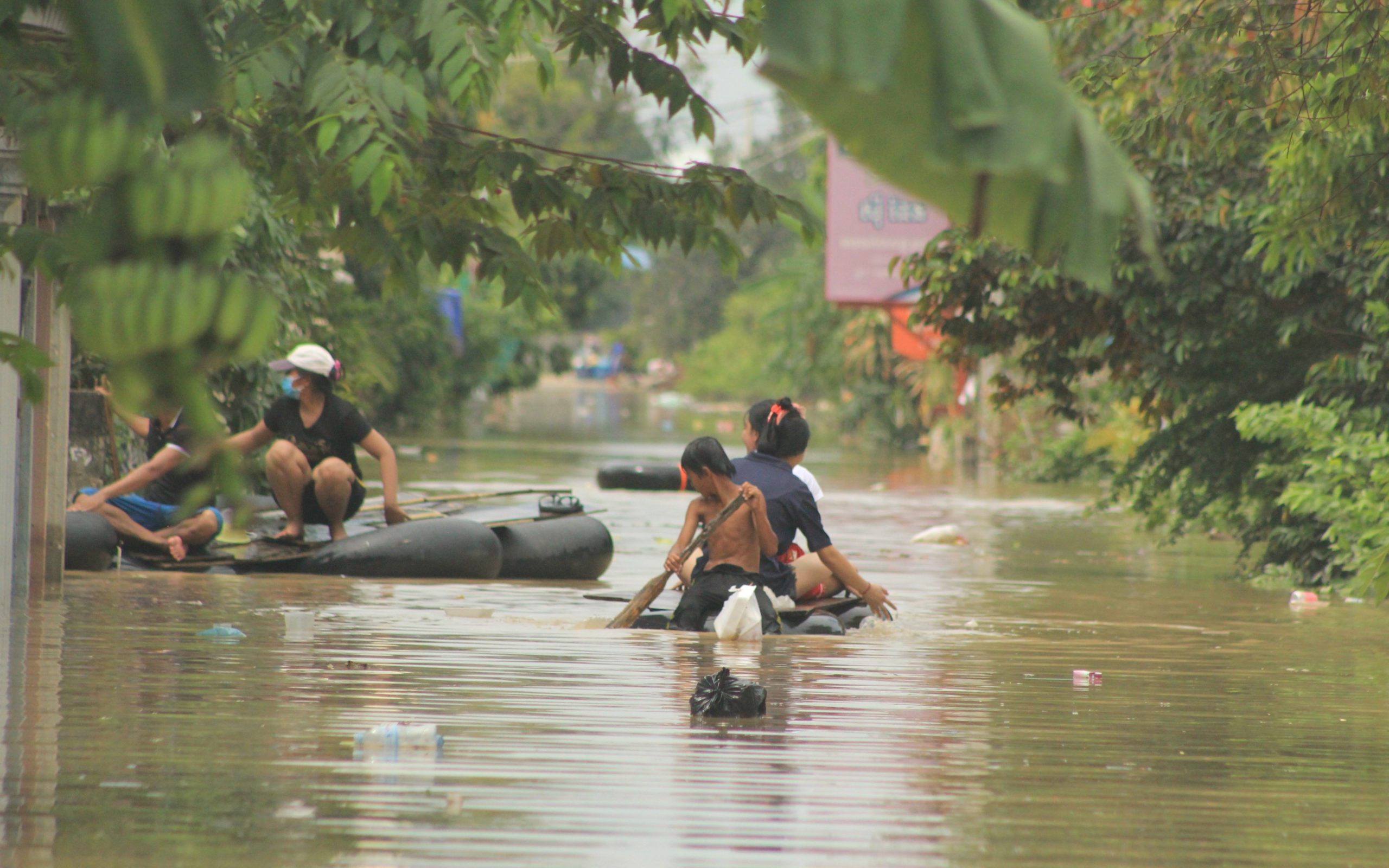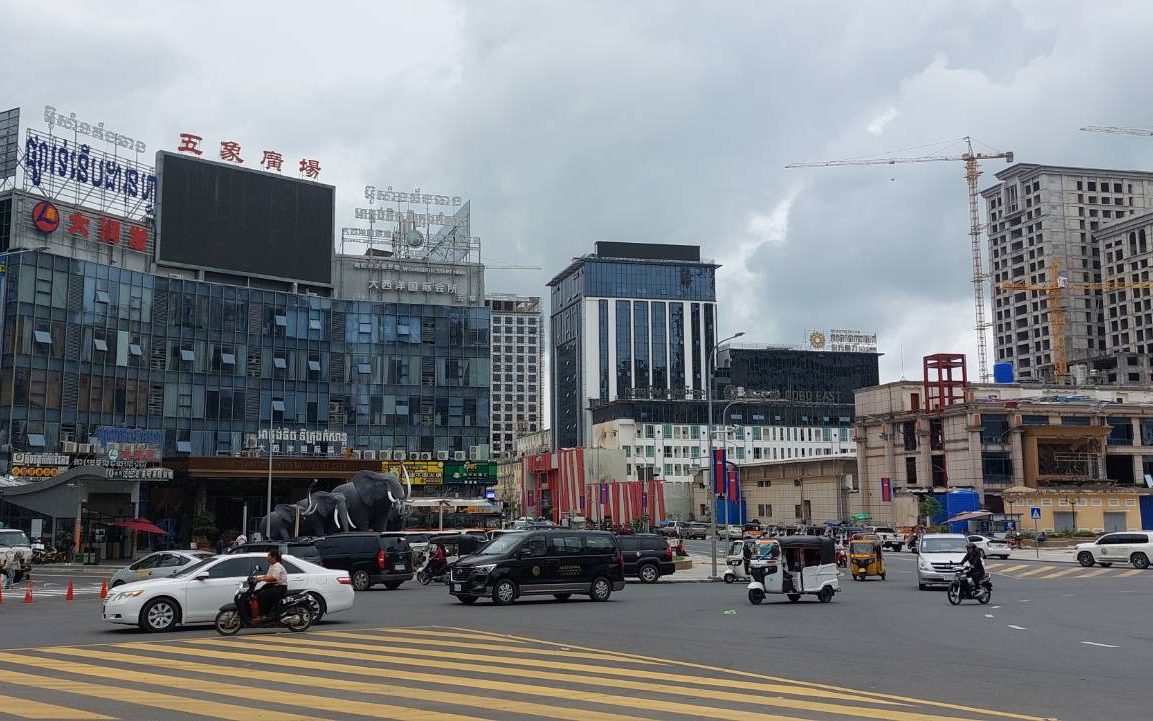It was just a dull thud in Mam Chantha’s back, with no pain at first. “I reached around, and I felt the blood.”
“I was smoking at the time,” Chantha continues. “My cigarette was in my left hand, so when I got hit, aside from the blood, I realized something was wrong because I couldn’t raise my cigarette to my mouth — my left arm was paralyzed.”
Chantha is smoking again at his home in Kandal province’s Ang Snuol district as he recalls the incident of June 3, when a soldier buried the bullet in his shoulder.
He remembers that it was only when the other protesters around him rushed over and made him sit down that the gravity of the situation became clear.
The spectacle of the earlier standoff was all around him — a platoon of soldiers waving their guns at assembled villagers, and the crowd raising their smartphone cameras in defiance.
Though the wound in his back was his alone, even in the moment the shooting was collective, as neighbors attended to him in concern and the footage was instantly beamed across social media, becoming etched into the collective consciousness of Cambodia.
Chantha is thankful for it.
“We were all shooting video. The soldiers were the only ones shooting bullets though,” he says, flashing a smile that comes out more like a grimace. Regaining his composure, Chantha adds that without the cameras the incident could have been disappeared. “If there’s no video, then there’s no shooting, and the country will go on not knowing about these things.”
Violence committed by the state against Cambodians — or “these things” as Chantha put it — is not infrequent. But amid villagers’ decadeslong struggle against land grabs, many are finding courage in filming and broadcasting authorities’ abuses live, across the country.
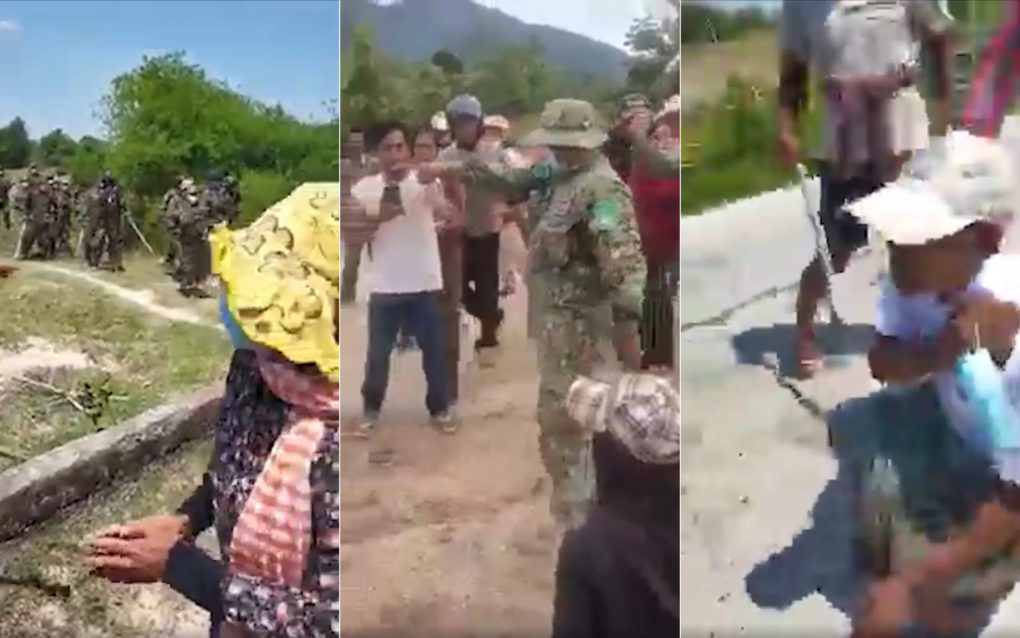
As Values Rise, Clashes Mount
For Chantha and his neighbors, violence erupted in the wake of a land dispute in which the government claimed it owned land that residents had farmed for decades.
“If nobody took pictures or videos, they would try to say we were encroaching on state land,” Chantha says. “What they did was a violation of our rights. They shot me — we weren’t doing anything. But if we had no cameras, they would’ve arrested us.”
According to local rights group Licadho, satellite imagery shows the disputed land being farmed since as far back as images are available in 2008. Residents say that about 300 families from at least seven villages in Tuol Pich commune used the land.
But military outposts began to crop up around the site, in close proximity to the Thmat Pong Military School, where the soldiers who fired on villagers were from.
“In May this year, they banned us from farming. They pointed guns at us and stopped us from accessing our land,” says Chantha. His land was a 28-by-72-meter plot that his family had farmed since 1979.
“It was my mother’s land,” he says. “We measured it out, but we still have no land title — the Forestry Administration took all the documents needed to get my land title, but we were told the officer who took those documents has since died and nobody knows what he did with our paperwork.”
For Chantha, the violence has coincided with a spike in land values across Kandal.
Elsewhere in the province, Phnom Penh’s new international airport, slated to open by 2023, has sparked ongoing protests, with residents even invoking a ceremonial curse upon the developers. Protesters say they want compensation in line with the value of the land they are being asked to vacate. Prices have multiplied since the airport development was announced, from around $8 to over $80 per square meter, they say.
Several prominent tycoons are also pursuing major developments on former state land in Kandal, including a Mekong river island and wetlands.
The province, which borders Phnom Penh, is also likely to see land values soar if the capital’s borders are expanded, as they have in the past. Phnom Penh’s 2035 Master Plan shows the capital city will be enlarged by as much as a 100 km radius, according to an anonymous article in the government-aligned Khmer Times.
Noch Song Heng, 58, who witnessed Chantha’s shooting, says land speculation is driving violence. He has been offered around $10 per square meter for his land, as local officials appear to be buying up disputed land in apparent anticipation of a land rush across Kandal.
“One official, he got 10 hectares very cheap. I can’t remember how much, but that’s why they’re using the army, to get us to sell,” Song Heng says. “There was a two-star general who fired twice in the air.”
It wouldn’t be the first time that the military has been used to further the real estate interests of Cambodia’s rich and powerful. A 2010 sub-decree enabled the Royal Cambodian Armed Forces to effectively act as private security firms for oknha such as Ly Yong Phat, Kith Meng and Try Pheap, a move the RCAF has defended, claiming that private financing has burnished underfunded units with much-needed weapons.
“They never would’ve dared to shoot without his permission. He’s like a parent. But in this case, when the parent makes a mistake, it’s one of his children who gets punished — the general will never be punished in Cambodia,” Song Heng chuckles.
The problem, he says, is that for all of the photographic and video evidence of the shooting that was produced by smartphone-wielding villagers, there was no footage showing the unnamed two-star general firing his weapon. Even so, the evidence gathered helped to shape the narrative and without it, the government would be free to construct its own.
“The camera is our weapon,” he says. “It lets us be seen.”
Documenting Disputes
This is a sentiment widely shared across Tuol Pich. Afraid to be named publicly for fear of retribution from the military, a group of seven villagers speak on the condition of anonymity that all were present on the day Chantha was shot.
“This isn’t the first case,” one woman says. “It’s been like this for 20 years now. This land has always been disputed by the government. But before they only used to shoot into the sky if we protested. Now they’re shooting at us.”
Villagers say about 10 residents confronted the excavator that arrived that morning escorted by soldiers. Word got around fast, and a group of 50 to 60 villagers ran back to their farms and returned with knives, machetes, sticks and a variety of other farmyard equipment, they say.
“When people started throwing rocks, I didn’t expect the soldiers to start shooting at us,” says another woman. “I was sure I’d have a heart attack. I didn’t expect to survive.”
Despite the panic, the villagers were compelled to collect bullet casings.
“After the shooting, we had to take them. It’s evidence that they shot their weapons,” says one man. “We need evidence. That’s why the phone cameras are so useful: We have to prove that we’re not the bad guys. We have to show who is doing the shooting.”
He goes on to describe how the residents, even as they fled, kept the cameras rolling over their shoulders to capture the chaos.
“Without videos to prove things, they can accuse us of anything,” he says. People were telling each other not to fight the soldiers — just get evidence.
Another woman says it’s vital that the evidence goes immediately online to avoid interference.
“It’s on Facebook in seconds, and it makes sure people can see it,” she says. “We have to collect our own evidence because the police can’t be trusted. They were the ones trying to pick up the bullet casings after the soldiers opened fire on us.”
“They wanted to make it look like there was no shooting,” she continues. “We have to disseminate the information because otherwise nobody will come to help us.”
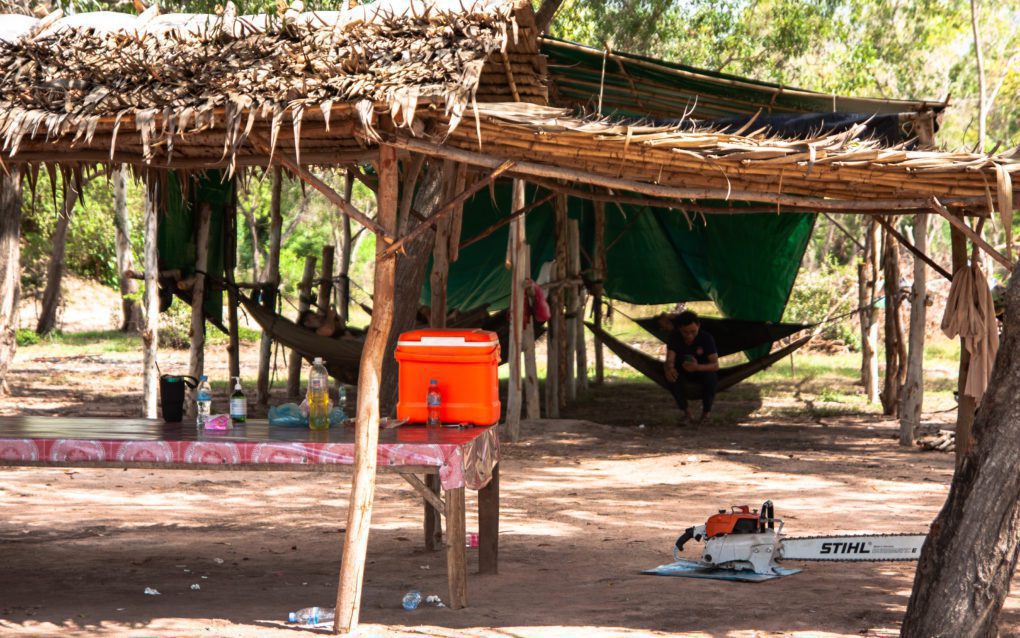
The Rise of Livestreaming
“It started a while ago, possibly in the Boeng Kak evictions,” says Eang Vuthy, director of land rights NGO Equitable Cambodia. “Not just activists, but documentary makers, journalists: Their use of video to capture evidence while investigating land rights abuses inspired people — it gave them a real sense that it was important to document these abuses.”
The prevalence of land grabs across Cambodia has fueled the phenomenon, he says. The volume of video evidence, especially of violence by authorities, is changing the way Cambodians perceive their country.
But he stops short of saying it is changing the way the authorities act in the face of resistance from the public.
“I would say that it goes both ways. What we’ve seen is that the police are more careful — they have their own people with cameras, they make sure to confiscate phones so there is no record, and this increases the risk for the people filming,” he says.
Police officers now cover their faces, as seen at protests on the anniversary of the Paris Peace Agreements last year, or they wear plain clothes and pretend to be journalists at street protests, he says.
In January, Phnom Penh Municipal Police chief Sar Thet issued a directive banning reporters from filming, photographing or livestreaming police while they worked on ongoing investigations. The directive was derided by press associations as “vague” and another blow to press freedoms in Cambodia.
A spokesperson for the National Police declined to comment on how their tactics had changed in the face of more public scrutiny and video evidence.
In May, as the government faced intense scrutiny for a Covid-19 lockdown that led to protests over food shortages, the Information Ministry warned journalists not to report in Phnom Penh’s “red zones.”
Arul Prakkash, senior program manager for Asia and the Pacific at Witness, an NGO that helps human rights defenders to utilize video and technology in their work, says livestreaming is key, especially in environments where authorities are known to confiscate SD cards from recording equipment.
“I think the ideal environment for livestreaming is dependent on the connectivity, so when you can livestream, you can engage an audience that can respond to the situation and the video is there unless it is deleted,” he says, though he cautions that authorities across the region are developing more sophisticated means of preventing filming and livestreaming.
He also warns of the dangers of filming in highly militarized situations.
Dead-End Courts
Prakkash notes that disputes involving politically connected individuals in jurisdictions with weak judicial independence like Cambodia are rarely solved by evidence, though public outcry can help.
Vuthy of Equitable Cambodia says justice in the courts is not something Cambodians can expect anytime soon. “But there is a Khmer saying: A drop of water can make a hole in a rock eventually.”
Oum Sophy knows the challenges. Her community’s land dispute traces back to 2001. The dispute came to a head in 2007, when Sophy was slapped with incitement charges in connection to a dispute with KDC International, a company co-owned by Chea Kheng, the wife of 75-year-old Energy Minister Suy Sem.
Land disputes have affected some 770,000 Cambodians since 2000 — some 6 percent of the population at the time, according to the International Federation of Human Rights. The involvement of tycoons, politicians and their well-connected families in land grabs and forced evictions presents an additional challenge for victims.
Some 175 families in Koh Kong were forcibly evicted when ruling CPP senator Ly Yong Phat, one of the wealthiest men in the country, received two land concessions that he ordered be cleared in 2006 to make way for a sugar plantation. Villagers, angry at having been given just days to abandon their homes, protested and refused to leave. The protests were dispersed after soldiers fired on the group, permanently disabling one villager, according to the Cambodian Center for Human Rights. The dispute remains unresolved and has, as of December 2020, now affected more than 2,000 families across three districts of Koh Kong, CCHR says.
Infamous timber tycoon Try Pheap, believed to own upward of 70,000 hectares of land granted through concessions, has been embroiled in land disputes across the country that saw as many as 1,500 families evicted between 2010 and 2013. Pheap was sanctioned by the U.S. Treasury Department in December 2019 on the grounds of corruption and human rights abuses, but many of the victims of his land grabs — which were facilitated through a number of companies owned by Pheap and his family — still have not received compensation.
But it’s not just wealthy Cambodians who are behind these land disputes. Last year Mitr Phol — a Thai sugar company — found itself dragged into a class action lawsuit by 711 families in Oddar Meanchey province who lost their land to the Thai sugar giant in 2008. Whether the Thai courts will represent a chance for Cambodians to hold foreign companies accountable for land grabs remains to be seen, but similar experiences were seen in Ratanakiri province when Vietnamese rubber company HAGL was granted some 59,000 hectares of land, including ancestral spirit mountains belonging to the indigenous communities. Despite being ordered to return land to the communities by the International Finance Corporation’s complaints watchdog in 2019, HAGL pulled out of the process, instead deferring to the Cambodian government, which has still not addressed the case. Likewise, Chinese Union Development Group has been accused of facilitating the evictions of hundreds of families across the coast of Koh Kong province.
In September 2020, some 1,100 people from at least four provinces descended on the Ministry of Land Management’s office in Phnom Penh to protest the lack of resolution to land disputes, some of which had dragged on for more than a decade. While Land Management Ministry officials could be seen looking down on the protesters from the building’s windows, no solution was offered and the protesters’ claims were dismissed by the government. The true scale of land disputes in Cambodia is difficult to accurately assess, but CCHR estimated that more than 2 million hectares of land had been granted as concessions between 2012 and 2020 and noted that concessions are often the heart of land disputes when wealthy, politically connected individuals or companies begin to claim the homes of communities with weak or no land tenure.
“When it’s hundreds or thousands or even millions of people angry, then the authorities really start to monitor the situation — even the prime minister will want to know — so it hinges on his support, if he is convinced, then you can win,” Vuthy says. “But events like the Boeng Kak evictions involved the Hun family. So even just getting the 11-hectare concession plot was a win for the evictees, as it’s very hard to take on people with powerful interests, even with evidence.”
For Sophy, this challenge was exacerbated by the lack of evidence that she and other villagers could collect before smartphones became more accessible in Cambodia.
“It was very difficult for us in the beginning because we did not have smartphones or Facebook. … We could only write what we saw and there was no picture or video to keep as evidence or complaint,” she says, adding that when KDC bulldozed her communities’ houses in 2008, authorities rejected her complaint due to a lack of evidence.
Sophy’s land dispute languished over the years, with no solutions offered, and it wasn’t until 2017 that she first got a smartphone.
“First we were very excited that we could use the phone to shoot [videos of] actions, but it took years to understand and use it,” she notes.
In February, authorities tore down a makeshift community hall Sophy was using to teach villagers about environmental issues.
She couldn’t challenge the men, but she can show their true faces, she says.
“We are women and we have nothing,” Sophy says. “I took videos of the incident and can show the men who did it. … All we have is the phone to shoot video evidence.”


